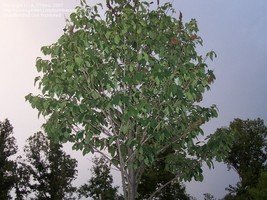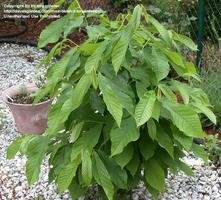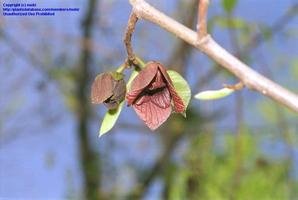





With a name like PawPaw, the fruit must have something incredible going for it. It took me awhile to try the fruit of the PawPaw tree, it's blooms have a nasty smell, and the fruit is nothing to look at. But after that first bite, ahhhhhhhh, the flavor.
I had a playhouse when I was growing up. It was a small log cabin that my grandfather had built for his two daughters. There was a mountain stream that bubbled alongside my home, and the playhouse had been built on the side of the front yard so that it's back was standing over the stream. It was a wonderful playhouse, with a porch on two sides and windows all around. I could stand on the little porch and watch the water creatures bubble past, surely on their way to the ocean that I had never seen. I had a pretty big imagination, even then. In front of the playhouse were shrubs, and a maple tree, but to the side and a bit closer to the creek was a pawpaw tree.
I didn't know much about pawpaw trees at the time, but I knew there were times when the tree bloomed it smelled very bad. I also knew that in the fall, those very ripe pawpaws would fall on my playhouse porch and make a slick gooey mess for me to clean up. But I learned to eat them by having to touch them. If they fell hard and were very ripe, they would splat as they hit the porch. Well, you know what happens when you are four or five years old and you get messy gooey fruit on your fingers. You stick those fingers in your mouth. So I learned to love the ripe pawpaw.
There were also the times when I would run as fast as I could and stop suddenly in the ripe pawpaws that were laying on the ground, then slide on my feet till they slipped out from under me and I landed splat on my behind in the middle of the ripe pawpaws. And I could tell about the pawpaw fights with the neighbor boys as they swaggered down the road past my playhouse, but neither of those events is really something I care to remember, since it brings up unpleasant memories of the swats with a switch from the weeping willow tree.
The pawpaw (Asimina triloba) is a small tree with large leaves and large fruit and it is native to eastern North America. It is also a member of the Annonaceae family, and it is the only member of that family not confined to the tropics. Those who have researched the tree have decided that the name "pawpaw" is probably derived from the Spanish word papaya. The trees were discovered in the early 1500's by the Spanish explorer Desoto on one of his excursions into the Mississippi valley. In 1776 they were mentioned in William Bartram's book, "Travels", he had found them growing along rivers in Georgia and east Florida. DeSoto found Native Americans cultivating the pawpaw. The Lewis and Clark Expedition depended and sometimes subsisted on Pawpaws during their travels. Chilled pawpaw fruit was a favorite of George Washington, and Thomas Jefferson planted it at Monticello. [1] [2]
The tree is sensitive to ultraviolet light and the pawpaw seedlings may not grow back after a forest has been harvested. There are very few forests in the United States that are still virgin. The pawpaw tree must be planted under the partial shade of other trees in order for them to strengthen enough to survive without cover. Pawpaw trees grow to be about 15 feet, so if they are planted as an understory, be sure that they will quickly outgrow the shading trees. In order to be prolific fruit bearers they need sunlight after the second year of growth. Because they have broad leaves, and broad leaves require large amounts of moisture, we can usually find them growing near a water source. The fruit itself resembles a cucumber in size and shape. Most people prefer eating the fruit after it has ripened, at which point in my experience it is very soft, mushy, and looks like an overdone baked potato. It also has flat black seeds, similar to those of the watermelon, and yes, I will admit I have been in some spitting contests with pawpaw seeds. The custard-like pulp can vary in color, going from light yellow to a deep orange and has the taste of a blend of several tropical flavors: banana, pineapple, and maybe mango. Since pawpaws do not have a long shelf life, they most likely will be found in roadside stands or in farmer's markets but not in your regular grocery. I must tell you, the best place to enjoy the pawpaw fruit is outside right off the tree.
Pawpaws are rich in minerals such as magnesium, copper, zinc, iron, manganese, potassium and phosphorus. It also contains an abundance of Vitamin C, proteins and amino acids and it is high in antioxidants. I also found in my research that it is pollinated by carrion flies and beetles, and some growers locate rotting meat near the trees at bloom time to increase the number of blowflies. The fruit may be eaten by foxes, possums, squirrels and raccoons, however the leaves and twigs of the pawpaw tree are seldom bothered by rabbits or deer. Asimina triloba is the only larval host of the Zebra Swallowtail Butterfly.[2]
The seeds also have insecticidal properties. Native Americans dried and powdered them and applied the powder to children's heads as well as their own to control lice. Some speciality shampoos now use compounds from pawpaws for the same purpose.
The pawpaw is the largest native fruit of North America, it has tremendous health benefits, yet as the forests disappear, so does the pawpaw tree. It is endangered or threatened in New York and New Jersey, there are few forests where it can grow, mature, and produce fruit naturally.[1]
In addition to the medicinal benefits, you might like to know that pawpaws make delicious desserts. Here is my favorite recipe, it is very similar to my grandmother's recipe for custard. The difference is that she used milk and cream from her cow, and she often sweetened with honey instead of sugar. Let me tell you, if you have never tasted the fruit of the pawpaw tree, one bite and you will be transported to a faraway tropical island. Go ahead, try it!
Pawpaw Custard Pie
1 c 2% milk
1 c cream
3 eggs
3/4 c sugar
1 c pureed pawpaw pulp
Mixing the ingredients as you add them, beat together the milk, cream, eggs, sugar and pawpaw. Pour the custard into a pie shell and bake at 450 F for 15 minutes, then reduce heat to 325 and bake an additional 40 minutes or until a knife inserted near the center of the pie comes out clean.[2]
[1] http://exinearticles.com/?History-Of-The-Pawpaw-Tree&id=370268
[2] http://en.wikipedia.org/wiki/Pawpaw
Other sources:
www.petersonpawpaws.com/culturalAdvice.php
http://www.pawpaw.kysu.edu/
Photos are from Plant Files. Thanks to Victorgardener, A_Ztrees, and Meki.
Copyright © www.100flowers.win Botanic Garden All Rights Reserved